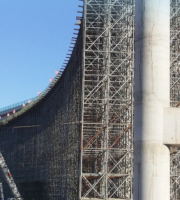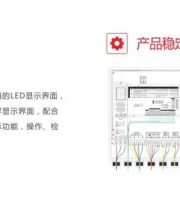3.
In case of electrical fire at the construction site, precautions for extinguishing the electrical fire: (1) quickly cut off the power supply to avoid the expansion of the situation.
Fire accidents not only bring economic losses, but also face news exposure, criminal detention and corporate image damage.
The distance between outdoor fire hydrants on site shall not be greater than 120 meters.
to set up a project volunteer fire brigade, carry out centralized training and education, and improve the emergency response ability..
Key point 5: set up a volunteer fire brigade, smoke-free on the whole site, transfer on-site team leaders, frequent hot work personnel, security personnel, etc.
Key point 3: regularly check and maintain the fire-fighting facilities, store the inflammables and explosives separately, and allocate sufficient fire-fighting equipment according to relevant regulations, especially pay attention to the thermal insulation of fire hydrants during winter construction.
Key point 4: strengthen the inspection and maintenance of temporary power lines, and timely replace and maintain the parts with overload, short circuit and other hidden dangers of on-site temporary power lines and aging lines.
Several instruments are used to cut wooden boards.
Fortunately, the accident did not cause casualties.
For class II hot work, the responsible engineer of the project shall organize the preparation of fire safety technical measures, fill in the hot work application form, and submit it to the project safety management department and the project leader for review and approval before hot work.
Explosives shall be stored separately in dangerous goods warehouse and locked and managed by specially assigned personnel.
For class III hot work, the team shall fill in the hot work application form, and the hot work can be carried out only after it is reviewed and approved by the project responsible engineer and the project safety management department.
Power off and lock the unused temporary power lines in time.
The hot work under any of the following conditions shall be classified as class I hot work: (1) hot work in the fire prohibition area; (2) Oil tanks, oil tanks, oil tankers, containers that have stored flammable gas or flammable gas and auxiliary equipment connected with them; (3) Various pressure equipment; (4) High altitude welding and cutting operation with high risk; (5) Relatively sealed indoor, container, basement and other places; (6) Places with a large amount of combustible and inflammable materials on site.
Inflammable materials (safety net, thermal insulation foam board, thermal insulation cotton felt, etc.) shall be stacked in a centralized manner, and obvious fire safety warning signs and no smoking signs shall be set.
The hot worker and fire watcher indicated on the hot work ticket shall not be replaced at will.
When the fire site is far away from the switch and it is necessary to cut off the wires, the live wire and the zero wire shall be cut off separately in a staggered manner to avoid short circuit at the jaw, and to prevent the power line from falling on the ground to cause short circuit and electric shock.
Characteristics of initial fire: the initial fire stage is a few minutes after the fire, with the characteristics of small combustion area, slow flue gas flow, little flame radiation heat, and slow temperature rise of surrounding objects and building structures.
(2) When the power line cannot be cut off in time due to other reasons, on the one hand, send someone to the power supply end to pull the switch, on the other hand, ensure that all parts of the human body should keep a sufficient distance from the electrified body, and wear insulating articles when extinguishing the fire.
The hot work ticket is valid on the same day.
Conductive fire extinguishing agents are strictly prohibited.
Key points of fire safety management and control at the construction site: 1.
In this stage, less manpower and emergency fire-fighting equipment are used to control or extinguish the fire.
Hot work under any of the following circumstances is classified as class II hot work: (1) temporary welding, cutting and other hot work in non fire prohibited areas with certain risk factors; (2) Fire operation of small oil tanks and other containers; (3) High altitude welding, cutting and other hot work (common class II hot work on the construction site).
The fire extinguishers at the construction site are mainly ABC 4kg dry powder fire extinguishers, 2 for each 100m2 of temporary facilities, and 2 for each 50m2 of processing sites such as woodworking workshop and paint room.
A fire ticket shall be issued before operation to specify the fire operator and fire watcher.
Key point 2: improvement of fire safety awareness of operators and training of initial fire fighting ability; Organize special training and education on fire safety, broadcast recent fire accident cases, popularize fire knowledge, publicize and implement the fire management system of the project department, at the same time, carry out fire emergency drills, master the use methods of fire-fighting facilities, and improve the ability of emergency disposal and initial fire fighting.
The following conditions are class III hot work: hot work in non fixed places without obvious risk factors is class III hot work.
(3) When extinguishing electrical fires, fire extinguishing agents with good insulation performance such as dry powder fire extinguishers, carbon dioxide fire extinguishers or dry sand shall be used.
2.
After the hot work site is changed or the hot work environment is changed, the hot work ticket shall be reissued.
Fire fighting principle at the initial stage: control first, then eliminate, save people first, distinguish between primary and secondary, control first, and then extinguish; Focus first, then general; Prevent poisoning and suffocation; Listen to the command and don’t panic.
Regularly check the sensitivity and effectiveness of fire-fighting equipment and whether it is moved or blocked.
1 government affairs building, Lingcheng Town, Lingbi County, Suzhou city.
After the hot work ticket is issued, a specially assigned person shall be arranged for patrol inspection, and the hot work personnel shall carry the hot work ticket for future reference.
For class I hot work, the project leader shall organize the preparation of the fire safety technical scheme, fill in the hot work application form, and submit it to the enterprise safety management department for review and approval before starting the hot work.
A complete set of preparation templates for safety data can be obtained for free.
Safety early warning: prevent fire accidents and do a good job in fire safety management in advance.
At 01:19 on May 28, a fire broke out at the construction site of the Kindergarten under construction behind No.
Check whether there are combustibles around the hot work environment, whether the protective measures for hot work are implemented, and whether the fire-fighting equipment is in place.
Strictly enforce the hot work approval system; Hot work approval system shall be strictly implemented for hot work.
Strengthen the inspection of private connection (especially in living quarters) of temporary power supply to prevent fire caused by electrical reasons.
Wear insulating gloves and use tools with insulating handles when cutting off the power supply.
After 30 minutes of intense rescue, the fire was successfully extinguished.
The hot work on the construction site is divided into class I hot work, class II hot work and class III hot work: 1.
Lingbi brigade immediately dispatched 2 vehicles and 12 people to the scene of the accident for disposal.
It is reported that the fire site is located on the third floor of the construction site, and the mold is being made.



